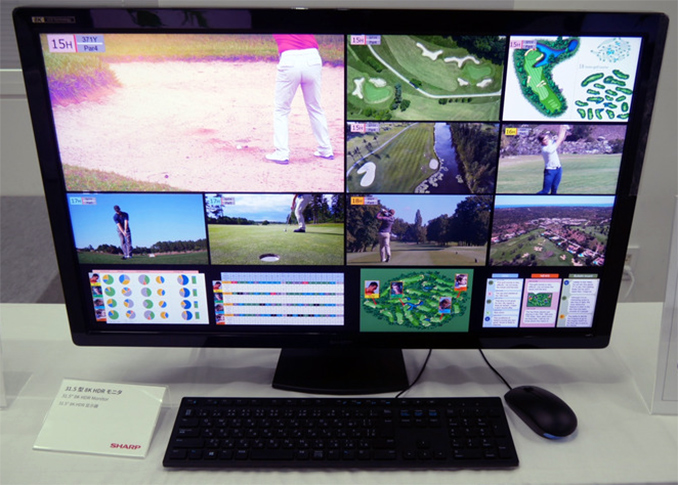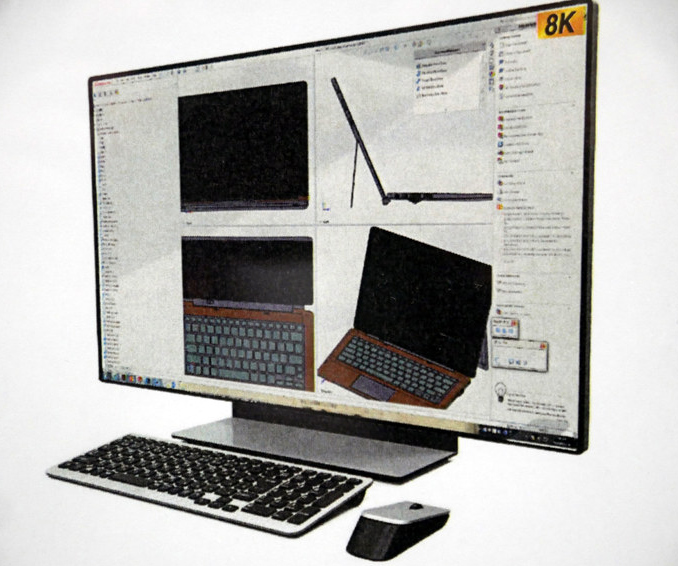Sharp Demonstrates 31.5-Inch 8K 120Hz HDR Monitor
by Anton Shilov on April 11, 2019 2:00 PM EST
Sharp this week demonstrated its first 31.5-inch HDR display featuring a 7680×4320 resolution and a 120 Hz refresh rate. The monitor uses the company’s IGZO technology and the manufacturer evaluates plans to release this LCD commercially.
Being one of the key backers of an 8K resolution as well as the Super Hi-Vision format, Sharp was among the first to release 8K screens and 8K cameras for professionals as well as 8K UHD TVs for consumers. Several years ago, Sharp demonstrated its first 27-inch 8K IGZO monitor with a 120 Hz refresh rate and 1000 nits luminance, but the device has never been released commercially (at least, it has not been available in stores). This week the company showcased another 8Kp120 display.
Demonstrated at a special media event in Sharp’s headquarters in Tokyo, the new prototype is a 31.5-inch IGZO LCD featuring a 7680×4320 resolution, 800 nits brightness, and a 120 Hz refresh rate. The new monitor is larger than its predecessor, yet features a lower pixel density, and lower luminance, so it should be a bit easier to manufacture (at least from cooling and PPI points of view).
Sharp did not disclose many technical details about its new 31.5-inch 8K LCD, yet the company is considering to launch it commercially. Meanwhile, one of the key questions is how the display will connect to host machines. To feed its 27-inch 8K monitor with data (7680×4320 at 10 bits at 120 times a second requires a minimum bandwidth of 120 Gbps or 15 GB/s), Sharp had to use eight DisplayPort cables back in 2016. VESA started to certify DP1.4 with HBR3 (DP8K) 32.4 Gbps cables in early 2018 and their use could reduce the number of DP connectors needed for 8Kp120 monitors. Usage of four cables is still too complicated for the mass market, yet it is acceptable for professional applications.
In addition to its 31.5-inch 8K HDR display, Sharp also showcased a picture of its all-in-one PC allegedly featuring the same 8K LCD panel. Development of such a PC may indicate that the company’s 8Kp120 HDR panel does not heat too much and it is possible to install compute components essentially on its back (though this is a speculation). Meanwhile, as paradox as it may seem, building an 8Kp120 AIO PC may be somewhat easier than building a desktop PC for such a display using the currently available technologies due to less clutter with cables, certifications, and so on.
At this point Sharp’s 8Kp120 AIO desktop is a prototype and it is unclear whether something like this could be released commercially any time soon. Meanwhile, Foxconn, the owner of Sharp and the world’s largest contract maker of electronics, has a lot of talented engineers who helped Apple to build its iMac Pro AIO workstation.
Related Reading:
- CEATEC 2016: Sharp Showcases 27-inch 8K 120Hz IGZO Monitor with HDR, also 1000 PPI for VR
- Philips Demos 328P8K: 8K UHD LCD with Webcam, Docking, Coming in 2018
- Dell Announces UP3218K: Its First 8K Display, Due in March
- Sharp Announces 2nd Gen 8K UHD TVs at IFA
- Samsung's 2019 QLED UHD TVs: 8K TVs Revamped, 4K TVs Get New Panel & Backlighting
- New 8K OLED Displays for Tablets and Laptops: 8.3 and 13.3 Inches
- Sharp’s 8K UHD TV Available in Japan, Listed in Europe for €11,899
Source: PC Watch











21 Comments
View All Comments
inighthawki - Thursday, April 11, 2019 - link
High refresh rate displays are nice to have beyond just gaming. Even for basic office work, the desktop becomes so smooth having 120+hz that I will personally never buy a 60hz display again. Simply moving the mouse cursor around feels sluggish by comparison. If it were my decision, 120hz would be the new standard and bare minimum for all new displays.Ironchef3500 - Friday, April 12, 2019 - link
+1 120hz for even every day tasks is sooo much nicer.ingwe - Thursday, April 11, 2019 - link
If you do both you may reach a wider audience. For instance someone might want to game at 120Hz at a lower resolution but also want to use 8K while writing code or something. So that person might be interested in one solution. Just a thought mostly because that is the way I am. Though I have yet to make the jump to 4K yet.ken.c - Thursday, April 11, 2019 - link
Give me this in a 40" monitor and we are talking. I run a 4K 40" Philips at work (instead of a pair of 27s or 30s) and I would love to have it pixel doubled.skunkworker - Friday, April 12, 2019 - link
This, I currently run 3 24" 1920x1200 monitors in portrait mode. I would love a proper 8k screen that covers a similar physical space but with the doubled resolution. I've been eying a 43" 4k but 8k would be great for text/web with 4k for gaming.teamet - Thursday, April 11, 2019 - link
4K, 120 Hz, decent HDR, ~30", less than $1000 and I'm a happy camperKevin G - Thursday, April 11, 2019 - link
Sharp could just cheat simply put the GPU into the display which connects to the display via Thunderbolt. The bandwidth requires to send commands to the display to process an image these resolutions is far less than the amount of bandwidth used by the raw pixel count.Alternative means would to use some AV-over-IP protocol and 100 Gbit Ethernet would do 7680 x 4320 @ 120 Hz 8 bpc without compression.
Otherwise DP 2.0 with compression (which is in draft state), or HDMI 2.1 with compression could also do this over a single cable.
thomasg - Saturday, April 13, 2019 - link
GPUs are attached to systems over PCIe.Even though it can be argued, that often 8 PCIe lanes are enough and not 16 as used by PEG, for PCIe 3.0 x8 this means a net transfer rate of roughly 63 gigabits per second - and in contrast to HDMI or DisplayPort this needs to be duplex.
So it's quite nonsensical, that the connection between PC and external GPU could be handled by a bus achieving less than the 32 Gbit/s for Displayport or 48 Gbit/s HDMI simplex transmissions.
There's a reason why duplex Thunderbolt 3 at roughly 30 Gbit/s (PCIe 3.0 x4) carries a performance penalty.
Kevin G - Monday, April 15, 2019 - link
You are thinking in terms of pixels, not raw command rate that is necessary to send to the GPU. It is less bandwidth intensive to send the commands used to generate an image than the high resolution bitmap. A bit over simplified, but imagine sending an image of a circle on the screen. At 8K 10 bit per channel, to display the full screen you'd need to transfer ~124 Mbyte per frame where as a draw command could need less than a kilobyte in terms of parameters: the center, inner radius, outer radius, color for the inner and outer, aliasing info.And yes, there is plenty of stuff in a normal workload that cannot be described by simple commands but GPUs have multi-gigabyte buffers on board to cache such things. Such raster data would only need to be sent once over the Thunderbolt link while being used (unless of course the GPU's onboard memory is not enough which performance would tank and this performance drop would still occur in 16x PCIe 3.0 slot too).
And yes, native 16x PCIe 3.0 is faster that Thunderbolt 3.0, especially at lower resolutions where there is CPU bottleneck. The GPU is essentially waiting on data from the CPU and the Thunderbolt 3.0 link can indeed be a bottleneck in this low resolution scenario. However, at 8K, we are far from the GPU waiting around for commands to be sent from the CPU. For this use-case, Thunderbolt 3.0 would be 'good enough'.
thomasg - Saturday, April 13, 2019 - link
Also, it should be noted, that Thunderbolt 3 cables may not exceed 0.5 meters (or 20 inches) to carry 40 Gbit/s linerate (~30 net rate), which makes it unacceptable for a monitor.Active cables may be longer, but are expensive and carry a latency penalty.